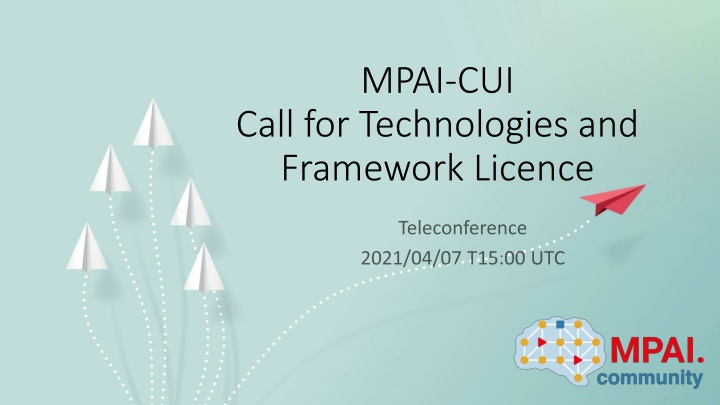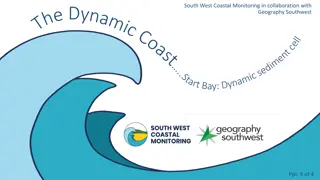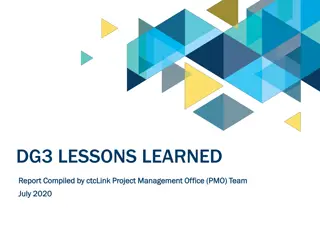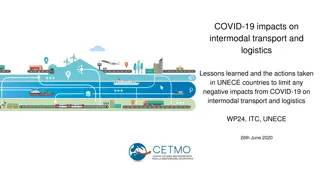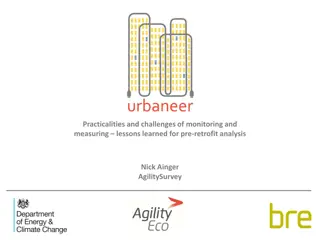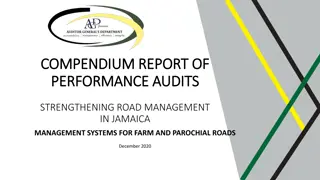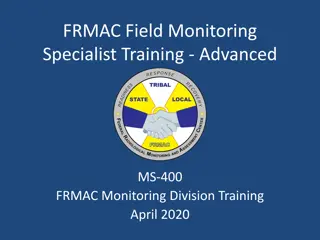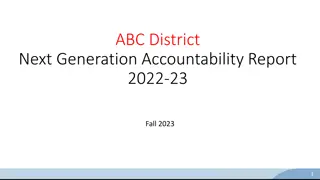Social Accountability: Lessons Learned and Next Steps
Social accountability strategies aim to enhance institutional performance by promoting citizen engagement and public responsiveness, encompassing aspects such as citizen monitoring, public information access, and resource allocation participation. Evaluating the impact of social accountability initiatives reveals mixed evidence, suggesting the need to rethink approaches towards sustainable collective action and avoiding elite capture.
Download Presentation

Please find below an Image/Link to download the presentation.
The content on the website is provided AS IS for your information and personal use only. It may not be sold, licensed, or shared on other websites without obtaining consent from the author.If you encounter any issues during the download, it is possible that the publisher has removed the file from their server.
You are allowed to download the files provided on this website for personal or commercial use, subject to the condition that they are used lawfully. All files are the property of their respective owners.
The content on the website is provided AS IS for your information and personal use only. It may not be sold, licensed, or shared on other websites without obtaining consent from the author.
E N D
Presentation Transcript
MPAI-CUI Call for Technologies and Framework Licence
Standards help industry and consumers
# Pillar 1 MPAI standards grow from Use Cases Functional Requirements Commercial Requirements Calls for Technologies Development Standard The MPAI foundations 2 MPAI standardises the I/O data of basic units called AI modules (AIM) an international 3 Aggregated AIMs are executed in a standard AI Framework (AIF) unaffiliated not-for-profit organisation 4 A Framework Licence is defined before a Call for Technologies is issued The MPAI activities of are based on 5 pillars 5 MPAI standard should include ethical considerations (under development)
Pillar #1 Standard development process Output: Publish Standard Activity: Approve Standard, Collect Declarations 6th MPAI standard Output: Text of Standard Activity: Develop Standard 5th Standard development Output: Call for Technologies Activity: Develop Call for Technologies 4th Call for technologies Prin- cipal Output: Framework Licence Activity: Develop Framework Licence 3rd Commercial requirements Asso- ciate Output: Use Cases and Functional Requirements Activity: Define requirements of work area 2nd Functional requirements Output: Functional Requirements work program Activity: Characterise use case 1st Use case All Output: MPAI Application Note # Activity: Collect and harmonise use cases 0th Interest collection
The foundations of MPAI standards Pillar #2: AI modules Pillar #3: AI Framework Management and Control Emotion Meaning Video AIM AIM Video analyser Time stamps Inputs Outputs AIM AIM Emotion and Meaning KB Communication Access Storage
Neural networks act as black boxes and are often not well-suited for applications that require explainability. Areas like employment, lending, education, health care and household assistants require explainability. In finance, machines predicting price changes is a significant win for companies, but without the explainability factor, it may be hard to convince regulators that it has not violated any regulations. Similarly, in transactions involving trust, such as credit card applications, one has to explain the reason for approval or rejection. In business applications, building the trust of a customer is critical, and decisions need to be explainable. Naga RayapatiArtificial Intelligence Beyond Deep Neural Networks, Forbes, 2021-03-24 Why do we need AIMs and AIFs?
A framework Licence is the IPR holders business model to monetise their IP in a standard without values: $, %, dates etc. The life cycle of a Framework Licence Before standard is developed:Active members develop & adopt the Framework Licence While standard is developed: Active membersdeclare to make available their licences according to the FWL after the standard is approved After standard is developed: All members declare they will get a licence for other members IPRs, if used, within 1 year after publication of IPR holders licensing terms Non members must get a licence from IPR holders to use an MPAI standard MPAI Members have already developed 3 Framework Licences Pillar #4: Framework Licences
Pillar #5: Ethics (under construction)
Component providers can offer conforming AIMs to an open competitive market Application developers can find the AIMs they need on the open competitive market Consumers have a wider choice of better AI applications from competing application developers Innovation is fuelled by the demand for novel/more performing AIMs Society can lift the veil of opacity from large, monolithic AI-based applications. Benefits of MPAI standards
MPAI-CUI Functional Requirements Guido Perboli Chair, MPAI-CUI Development Committee (CUI-DC)
AI-based Company Performance Prediction Management and Control Governance Assessment Governance Adequacy of organ. model Governance features Governance data (raw data) Financial statement Prediction Data conversion Decision Decision tree Default probability Assessment Financial statement (raw data) Financial Financial statement Financial features Default probability Perturbation Risk assessment technical industrial data (raw data) Business continuity index Matrix Risk assessment Technical data Risk matrix severity Risk Storage Communication
AI-based Company Performance Prediction Management and Control Governance Assessment Governance Adequacy of organ. model Governance features Governance data (raw data) Financial statement Prediction Data conversion Decision Decision tree Default probability Assessment Financial statement (raw data) Financial Financial statement Financial features Default probability Perturbation Risk assessment technical industrial data (raw data) Business continuity index Matrix Risk assessment Technical data Risk matrix severity Risk Storage Communication
AIM Function Data Conversion Gathers data needed for the assessment from internal and external) sources, in different formats and covert it to a unique format (e.g., json). Financial assessment Analyses company data (i.e., financial statements) to assess the preliminary financial performances in the form of indexes. Builds and extracts the financial features for the Decision tree and Prediction AIMs. Purpose of AIMs Governance assessment Builds and extracts the features related to the adequacy of governance asset for the Decision tree & Prediction AIMs. Builds the risk matrix to assess the impact of vertical risks (i.e., in this Use Case cyber and seismic). Risk matrix Decision Creates the decision trees for making decisions. Predicts company default probability within 36 months and of the adequacy of the organizational model. Prediction Perturbs company crisis probability computed by Prediction, considering vertical risks impact on company performance. Perturbation
Governance data are attributes that indicate the governance structure of a company and the roles of key personnel. MPAI-CUI Functional Requirements and Technologies contains examples. Requested: Other features are welcome. Some technologies requested by the Call Financial data from financial statement Data conversion, e.g., format: XBRL and json Requested: Digital representation of financial statement with universally valid semantics Risk assessment technical data are attributes that indicate internal assessment on vertical risks according to ISO 31000 Requested: Digital representation
Governance and Financial attributes are indexes and parameters needed for the assessment. Requested: governance data ontology that captures today s global-level practice. Some technologies requested by the Call Decision support tool to predict the probability of company crisis and bankruptcy E.g., tree-like model Requested: Other tools are welcome For details on these and other technologies please consult MPAI-CUI Use Cases and Functional Requirements
All technologies requested by the Call Data Technologies Governance data Ontology Financial Statement Data Digital representation with universally valid semantics Risk assessment technical data Digital representation Data conversion E.g., JSON Financial features E.g., indexes and parameters Governance features E.g., indexes and parameters Severity Decision support tool E.g., tree like decision model Default probability Adequacy of organisational model Business continuity index
An open reference model The MPAI-CUI reference model is the result of long discussions among MPAI experts However, the model is not closed MPAI welcomes proposals for Addition and removal of data streams from/to AIMs Different partitioning of the reference model in new AIMs Proponents should justify new data and partitioning Such proposals will be discussed and may be accepted if agreement is found
Submitting a proposal in response to the MPAI-CUI CfT Panos Kudumakis
Purpose of MPAI-CUI call To request technologies that: Satisfy the MPAI-CUI Functional Requirements _and_ Released based on the MPAI-CUI Framework Licence, if selected Seeking comments on technologies or architectural components: Additions or removals of I/O data justifying changes and identifying formats Alternative partitioning of the AIMs providing: Arguments in support of the proposed partitioning Detailed specifications of the I/O data of the new AIMs New Use Cases fully described Parties having relevant technologies should be aware that: MPAI-CUI, Use Cases and AIM internals will be non-normative. The I/O interfaces of the AIMs will be normative.
Submission and assessment 1. Respondents must present their submission or proposal will be discarded. 2. MPAI will select technologies on the basis of their technical merits 3. MPAI may not select a particular technology or may not select any technology if those submitted are found inadequate. 4. Upon acceptance of a submission or part thereof, MPAI requires that: 1. A working implementation be made available before the technology is accepted. 2. Provided in compiled or interpreted or hardware description languages, suitable for operation in the MPAI-AIF Framework. 5. Implementation used to develop and publish implementation standard 6. A non-MPAI member immediately join MPAI, or submission is discarded.
Submission and assessment 1. An evaluation panel will be created from: 1.All DC members attending. 2.Non-MPAI members who are respondents. 3.Non respondents/non MPAI member experts may be invited in a consulting capacity. 2. No one from 1.1.-1.2. will be denied membership in the Evaluation panel. 3. Respondents present their proposals and Evaluation panel asks questions. 4. If required, appropriate tests and studies will be carried out 5. Evaluation panel members fill out Annex B for each proposal. 6. Respondents respond to evaluations. 7. Proposal evaluation report is produced.
<Company> submits this technical document in response to MPAI Call for Technologies for MPAI project MPAI-CUI. <Company> explicitly agrees to the steps of the MPAI standards development process defined in Annex 1 to the MPAI Statutes, in particular <Company> declares that itor its successors will make available the terms of the Licence related to its Essential Patents according to the Framework Licence of MPAI-CUI, alone or jointly with other IPR holders After approval of the MPAI-CUI standards by the General Assembly and In no event after commercial implementations are available on the market. Mandatory statement
Step Date GA Call for Technologies 2021/03/17 MPAI-6 CfT introduction conference call #1 2021/03/31T15:00 UTC CfT introduction conference call #2 2021/04/07T15:00 UTC Notification of intention to submit proposal 2021/04/13T23.59 UTC Submission deadline 2021/05/10T23.59 UTC Evaluation of responses starting on 2021/05/12 MPAI-8 Timeline
MPAI-CUI Framework Licence Davide Ferri Chair, CUI-FWL
MPAI Framework Licence General Principles In the context of new standards, IPRs are the engine that ensure and sustain technology innovation. FWLs improve vague FRAND declarations, inadequate to give guidelines for setting licenses for standard essential IP. FWLs are developed by Active MPAI members, i.e., those who intends to contribute to the technical development of an MPAI standard MPAI replaces FRAND declarations with FWLs defined as the set of conditions to create a subsequent License
The License will: be in compliance with generally accepted principles of competition law and the MPAI Statutes cover all of Licensor s claims to Essential IPR practiced by a Licensee of the MPAI-CUI standard cover Development Rights and Implementation Rights apply to a baseline MPAI-CUI profile MPAI-CUI FWL: Basic terms for future Licenses Licenses Access to Essential IPRs of the MPAI-CUI standard will be granted in a non-discriminatory fashion. The scope of the License will be subject to legal, bias, ethical and moral limitations
The Licensefor Development and Implementation Rights, to the extent it is developed and implemented only for the purpose of evaluation or demo solutions or for technical trials, will be free of charge MPAI-CUI FWL: Basic terms for future Licenses Licenses A license free of charge for limited time and a limited amount of forfeited royalties will be granted on request The total cost of the Licenses issued by IPR holders will be in line with the total cost of the licences for similar technologies standardised in the context of SDOs take into account the value on the market of the technology standardised by MPAI.
Joining MPAI Leonardo Chiariglione
Be a legal entity or an individual representing a technical departments of a university Supporting the MPAI mission and Able to contribute to the development of MPAI standards Choose one of the two classes of membership: Principal Members, with the right to vote (2400 p.a.) Associate Members, can participate in standard development (480 p.a.) Send secretariat@mpai.community a copy of The template for MPAI Membership applications (signed) The MPAI Statutes. Each page should be signed and initialled The bank transfer See: mpai.community/how-to-join/join/ If you wish to join MPAI, you should
If you intend to make a submission Check the Calls web page at https://bit.ly/2Py4h11 Communicate to the secretariat your intention to respond to the Call (secretariat@mpai.community) by 12th of April Prepare your submission using the templates at https://bit.ly/2Prb4JK Send your submission to the secretariat by 10th of May Be ready to present (online) your proposal at the time indicated to you by the secretariat Get familiar with the evaluation process described in the Call Regularly check the Call web page for news (https://bit.ly/2Py4h11)
